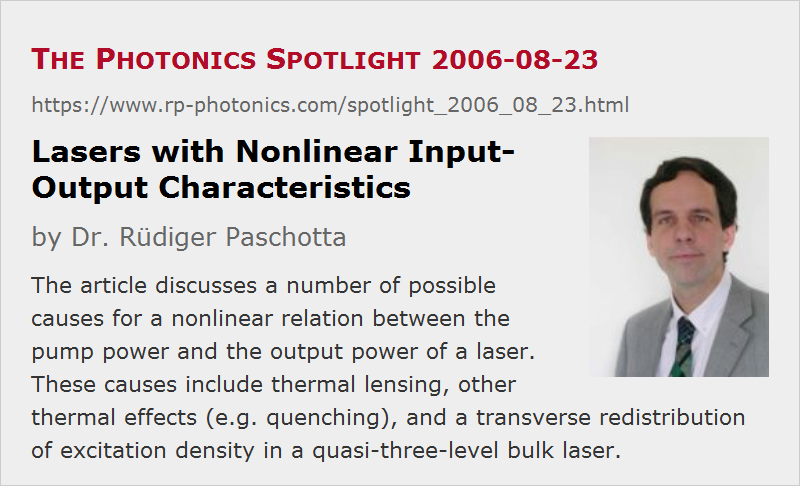Lasers with Nonlinear Input–Output Characteristics
Posted on 2006-08-23 as a part of the Photonics Spotlight (available as e-mail newsletter!)
Permanent link: https://www.rp-photonics.com/spotlight_2006_08_23.html
Author: Dr. Rüdiger Paschotta, RP Photonics Consulting GmbH
Abstract: The article discusses a number of possible causes for a nonlinear relation between the pump power and the output power of a laser. These causes include thermal lensing, other thermal effects (e.g. quenching), and a transverse redistribution of excitation density in a quasi-three-level bulk laser.
Ref.: encyclopedia articles on slope efficiency, thermal lensing, four-level and three-level gain media

The slope efficiency of a laser is an often used quantity, but there are actually plenty of cases where such a specification makes no sense – simply because there is no linear relation between pump power and output power!
The possible reasons for such behavior are manifold:
- In high power lasers (particularly in rod lasers), thermal lensing is often so strong that the laser resonator is pulled through the whole stability zone when the pump power is varied. As a result, the mode size in the gain medium (and everywhere else) can undergo large changes, which have a substantial impact on the power efficiency. The laser may even have a substantially increased threshold pump power, if the resonator becomes stable only through the influence of the strong thermal lens. Quite obviously, the effective slope efficiency does then no more simply reflect basic properties such as pump absorption efficiency, quantum defect, etc.
- Thermal effects can decrease the efficiency at high powers, thus making the input–output curve more flat or even bending it downward at high pump powers. The possible physical effects behind that are manifold: e.g. a modified thermal distribution in the Stark level manifolds of solid-state gain media or in the bands of a semiconductor laser medium, thermally induced quenching, or a thermally induced reduction of confinement factor in a VCSEL.
- Even without thermal effects, quasi-three-level bulk lasers can exhibit a nonlinear input–output relation – often with the curve becoming steeper at higher power levels. This behavior can be reproduced only with laser models taking into account the transverse variation of intensities and excitation density. It is related to the transverse redistribution of excitation density via gain saturation. (For more details, have a look at The Photonics Spotlight 2016-12-13.)
- Particularly in fiber lasers, nonlinear effects can reduce the output powers for strong pumping. For example, stimulated Raman scattering may transfer substantial amounts of power into some longer-wavelength Stokes wave.
- Power-dependent saturation of a saturable absorber in a passively mode-locked laser introduces some nonlinearity in the input–output curve, but this effect is normally not very strong.
It may not always be easy to find out what the actual cause of the observed effect is. However, as long as this hasn't been accomplished, one cannot be sure e.g. what is the reason of a non-satisfactory power efficiency.
This article is a posting of the Photonics Spotlight, authored by Dr. Rüdiger Paschotta. You may link to this page and cite it, because its location is permanent. See also the RP Photonics Encyclopedia.
Note that you can also receive the articles in the form of a newsletter or with an RSS feed.
Questions and Comments from Users
Here you can submit questions and comments. As far as they get accepted by the author, they will appear above this paragraph together with the author’s answer. The author will decide on acceptance based on certain criteria. Essentially, the issue must be of sufficiently broad interest.
Please do not enter personal data here; we would otherwise delete it soon. (See also our privacy declaration.) If you wish to receive personal feedback or consultancy from the author, please contact him e.g. via e-mail.
By submitting the information, you give your consent to the potential publication of your inputs on our website according to our rules. (If you later retract your consent, we will delete those inputs.) As your inputs are first reviewed by the author, they may be published with some delay.
 |





If you like this page, please share the link with your friends and colleagues, e.g. via social media:
These sharing buttons are implemented in a privacy-friendly way!